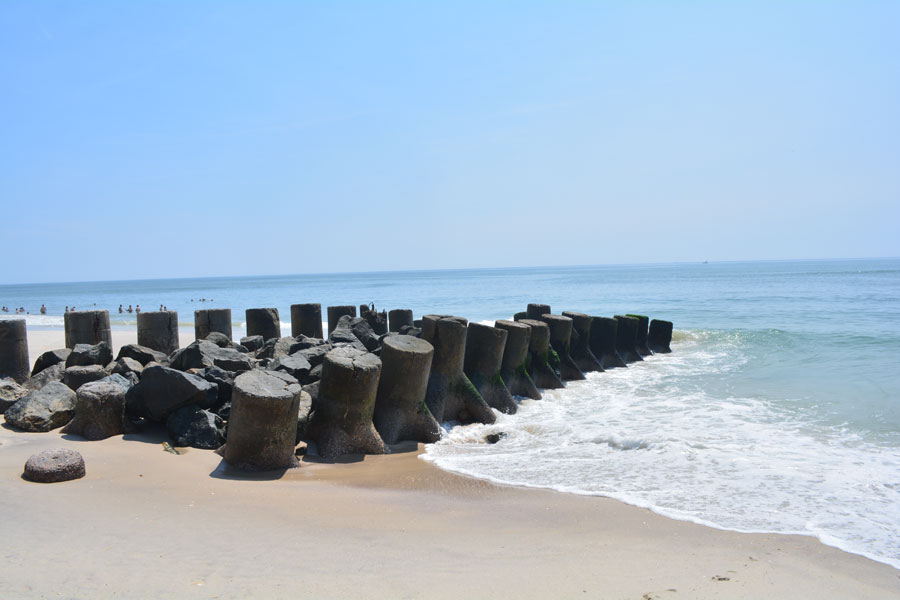The Atlantic Ocean

The Atlantic Ocean is not merely a body of water bordering Long Island, it is the force that has shaped its coastline, economy, ecology, and culture for centuries. Stretching from Montauk Point in the east to the barrier islands of Jones Beach, Fire Island, and Long Beach in the west, the Atlantic defines the very identity of Long Island as both a maritime community and a world-renowned beach destination.
From its powerful surf along the South Shore to the calmer waters of the Great South Bay and Peconic Estuary, the Atlantic influences nearly every aspect of life on the island – from weather patterns and tourism to fishing, shipping, and conservation.
Geography & Coastal Landscape
Long Island’s southern shoreline runs roughly 120 miles along the Atlantic Ocean, forming one of the most continuous stretches of sandy beach on the U.S. East Coast.
- Barrier islands – such as Jones Beach Island, Fire Island, Westhampton Beach, and Dune Road – act as natural buffers, protecting the mainland from the ocean’s force.
- Inlets like Fire Island Inlet, Moriches Inlet, and Shinnecock Inlet allow tidal exchange between the ocean and the island’s inner bays.
- Dune ecosystems and salt marshes provide critical habitat for shorebirds, fish nurseries, and migratory species.
The Atlantic’s constant motion – through tides, waves, and storms – continuously reshapes the coastline, shifting sands and altering inlets in an ongoing natural process that defines Long Island’s geography.
History & Maritime Significance
Since Long Island’s earliest settlements, the Atlantic Ocean has served as a highway, a resource, and at times, a threat.
- Indigenous peoples, including the Montaukett and Shinnecock tribes, lived in harmony with the ocean, harvesting shellfish and fish from the South Shore.
- European settlers in the 1600s established fishing villages and whaling ports such as Sag Harbor, which thrived on ocean trade.
- In the 19th century, the coast saw the rise of life-saving stations (predecessors to the U.S. Coast Guard) due to frequent shipwrecks on shifting sandbars.
- World War II brought submarine patrols and coastal defenses to Long Island’s Atlantic front, remnants of which still exist at Camp Hero in Montauk and Fort Tilden in Queens.
Today, the Atlantic continues to be the foundation for Long Island’s maritime industries – from commercial and recreational fishing to shipping, tourism, and offshore energy initiatives.
Recreation & Beaches
The Atlantic Ocean is the centerpiece of Long Island’s tourism and recreation economy. Millions visit annually to enjoy its white-sand beaches, surfing waves, and coastal parks.
Notable Atlantic-Facing Beaches
- Jones Beach State Park (Wantagh) – Iconic public beach with miles of boardwalk and ocean swimming.
- Robert Moses State Park (Babylon) – A family-friendly beach with fishing piers and surf spots.
- Fire Island National Seashore – Accessible only by ferry; home to pristine dunes, wildlife, and historic lighthouses.
- Cupsogue Beach County Park (Westhampton Beach) – A popular South Fork oceanfront with lifeguards, concessions, and camping.
- The Hamptons Beaches (East Hampton, Southampton, Montauk) – World-famous for their beauty, luxury homes, and rolling surf.
- Long Beach (Nassau County) – A lively oceanfront city with a boardwalk, events, and surf culture.
Beyond swimming and sunbathing, Long Islanders embrace ocean activities year-round – including surfing, saltwater fishing, diving, sailing, and wildlife photography.
Marine Life & Ecology
Long Island’s Atlantic waters host a rich marine ecosystem:
- Fish species such as striped bass, bluefish, fluke, and tuna thrive in offshore and inshore waters.
- Marine mammals, including dolphins, whales, and seals, are now frequently spotted off Montauk and Fire Island.
- Shorebirds like piping plovers and terns nest along the dunes, protected under conservation programs.
- The ocean’s Gulf Stream currents influence both the region’s climate and the diversity of its marine life.
Environmental stewardship remains a priority, with ongoing efforts by New York State Parks, NOAA, and local nonprofits to address erosion, pollution, and habitat loss.
Climate, Weather, and Ocean Influence
The Atlantic Ocean plays a dominant role in shaping Long Island’s climate – moderating summer heat and winter cold. Coastal breezes and ocean currents keep temperatures milder than inland New York.
However, the same proximity brings coastal storm risks. Hurricanes, nor’easters, and tidal surges have left lasting impacts – from the 1938 Long Island Express hurricane to Superstorm Sandy in 2012.
In response, local and state agencies have undertaken major coastal resiliency projects: dune restoration, wetland protection, and stricter building codes in flood zones.
Economic and Cultural Importance
The Atlantic supports tens of thousands of jobs across Long Island:
- Tourism and hospitality rely heavily on oceanfront destinations.
- Commercial fishing ports like Montauk and Hampton Bays contribute millions to the state’s seafood industry.
- Recreational boating and marinas line the South Shore, fueling small-business economies.
- New frontiers such as offshore wind energy – notably the South Fork Wind Farm, New York’s first commercial offshore wind project – underscore the ocean’s evolving role in sustainable development.
Culturally, the Atlantic has inspired artists, writers, and filmmakers for generations. From the beaches of The Great Gatsby to the breaking waves immortalized in Endless Summer-style surf culture, the ocean remains an indelible symbol of Long Island life.
Key Facts & Details
| Detail | Information |
|---|---|
| Ocean | Atlantic Ocean |
| Coastline Length (South Shore) | ~120 miles |
| Major Barrier Islands | Jones Beach Island, Fire Island, Westhampton, Dune Road |
| Main Inlets | Fire Island Inlet, Moriches Inlet, Shinnecock Inlet |
| Notable Beaches | Jones Beach, Robert Moses, Fire Island, Cupsogue, Long Beach, Montauk |
| Water Temperature (Seasonal Range) | 39°F – 75°F (4°C – 24°C) |
| Average Summer Surf Height | 2 – 5 ft (varies seasonally) |
| Wildlife | Whales, dolphins, seals, striped bass, bluefish, shorebirds |
| Economic Drivers | Tourism, fishing, boating, real estate, renewable energy |
| Environmental Concerns | Erosion, sea-level rise, habitat preservation |
The Atlantic Ocean is both guardian and sculptor of Long Island; its ever-changing tides have written the island’s story from prehistoric glacial sands to today’s vibrant coastal communities. It continues to define Long Island’s character as a place where the sea meets daily life, shaping its weather, economy, recreation, and sense of wonder.
Whether viewed from the dunes of Fire Island, the cliffs of Montauk, or the bustling boardwalks of Long Beach, the Atlantic stands as Long Island’s eternal horizon – a living force that connects the island’s past, present, and future.

